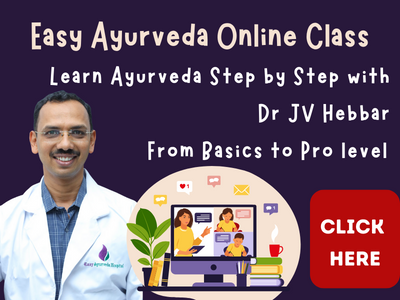Sushruta Samhita Sharirasthana Chapter 9 Dhamani Vyäkaraņa Shariram (Description of Arteries)
The 9th chapter of Sharirasthana of Sushruta Samhita is named as Dhamani Vyäkaraņa Shariram Adhyaya. This chapter deals with Description of Arteries.
अथातो धमनीव्याकरणं शारीरं व्याख्यास्यामः ॥१ ॥
यथोवाच भगवान् धन्वन्तरिः ॥२ ॥
We will now expound the chapter by name Dhamanī vyakarana sarira detailed description of Arteries, as revealed by the venerable Dhanvantari. Dhamani pratyekata, distinctness of arteries
Table of Contents
Reasons for differences between dhamanis, siras and srotas
चतुर्विशतिर्धमन्यो नाभिप्रभवा अभिहिताः ।
तत्र केचिदाहुः – सिराधमनीस्रोत सामविभागः,
सिराविकारा एव हि धमन्यः स्रोतांसि चेति ।
तत्तु न सम्यक्,अन्या एव हि धमन्यः
केवलं तु परस्परसन्निकर्षात् सदृशागमकर्मत्वात् सौक्ष्याञ्च विभक्तकर्मणामप्यविभाग इव कर्मसु भवति ॥३ ॥
The fact that there are twenty-four dhamanis arising from nabhi – umbilicus has been stated earlier in 14th chapter of Sutra Sthana of this treatise (Sushruta Samhita).
Commenting on this, some experts opine that there is no difference between sira – veins, dhamanis – arteries and srotas – channels of the body. According to them, dhamani and srotas are modifications of siras only. But this view is incorrect.
Dhamani and srotas are different from the siras.
What is the reason?
They are different because of below mentioned reasons –
– Vyanjananyatva – they have different features which shows that they are different structures
– Mula sanniyama – they differ in their numbers at the place of their origin
– Karma vaisesya – they have separated designated functions i.e. they serve different functions and those functions are special to each of them and
– Agama – description in scriptures i.e. treatises of Ayurveda, which describe them differently
In spite of these structures performing different functions, they appear to be indifferent from each other due to the below mentioned reasons –
– Sannikarsa – due to their proximity, they are so near to each other that they appear to be one and the same,
– Sadrsaagamatva – similarity of description of these structures in texts of Ayurveda
– Sadrsakarmatva – similarity in the functions they render and
– Saukshmya – all structures being minute in nature
Dhamanī Vibhāga – ramifications of arteries
तासां तु खलु नाभिप्रभवाणां धमनीनामूर्ध्वगा दश,दश चाधोगामिन्यः,चतस्त्रस्तिर्यग्गाः ॥४ ॥
The ten dhamanis arising from Nabhi – umbilicus takes different routes. Below mentioned are the different course of these ten dhamanis –
– Ten of them move upwards. They are called Urdhwagami Dhamanis.
– Ten of them spread downwards. They are called Adhoga Dhamanis.
– The other four of them move sideward or take transverse route. They are called Tiryakga Dhamanis.
Urdhvagădhamanī– arteries spreading upward
ऊर्ध्वगाः शब्दस्पर्शरूपरसगन्धप्रश्वासोच्छासजृम्भितक्षुद्धसितकथितरुदितादीन् विशेषानभिवहन्त्यः शरीरं धारयन्ति । तास्तु हृदयमभिप्रपन्नास्त्रिधा जायन्ते,तास्त्रिंशत् । तासांत वातपित्तकफशोणितरसान् द्वे द्वे वहतस्ता दश,शब्दरूपरसगन्धानष्टाभिर्गृह्णीते, द्वाभ्यां भाषते,
द्वाभ्यां घोषं करोति,द्वाभ्यां स्वपिति,द्वाभ्यां प्रतिबुध्यते,द्वे चाश्रुवाहिन्यौ,द्वे स्तन्यं स्त्रिया वहतः स्तनसंश्रिते,ते एव शुक्रं नरस्य स्तनाभ्यामभिवहतः;तास्त्वेतास्त्रिंशत् सविभागा व्याख्याताः ।
एताभिरूचं नाभेरुदरपार्श्वपृष्ठोरःस्कन्धग्रीवाबाहवो धार्यन्ते याप्यन्ते च ॥५॥
ऊर्ध्वंगमास्तु कुर्वन्ति कर्माण्येतानि सर्वशः ॥
Functions of the dhamanis spreading upwards –
The Urdhwaga Dhamanis which are 10 in number and spreading upwards, support and maintain the functions of the body by attending to the below mentioned functions –
– Reception / perception of sensations of sound, touch, sight, taste and smell by their respective sense organs
– Inspiration and expiration of air
– Yawning
– Sneezing
– Laughing,
– Talking,
– Crying and
– Many other such functions
Each of these dhamanis after reaching the heart divide into three branches. Thus, they become thirty in number.
Of these,
– 2 dhamanis carry vata
– 2 dhamanis carry pitta
– 2 dhamanis carry kapha
– 2 dhamanis carry rakta
– 2 dhamanis carry rasa
– 2 dhamanis carry sensation of sound
– 2 dhamanis carry sensation of sight
– 2 dhamanis carry sensation of taste
– 2 dhamanis carry sensation of smell
– 2 dhamanis attend to speaking in words
– 2 dhamanis attend to shouting out loud sounds without words being used
– 2 dhamanis attend to the function of sleeping
– 2 dhamanis attend to function of waking up
– 2 dhamanis carry tears
– 2 dhamanis carry breast milk in the breasts of women and 2 dhamanis carry semen from the breasts in men
Thus, the thirty dhamanis are described based on their divisions and functions.
These dhamanis support and maintain the parts of the body above the umbilicus including abdomen, flanks, back, chest, shoulders, neck, arms etc. The urdhwa dhamanis perform all these mentioned functions throughout the life.
Adhoga Dhamanī – arteries spreading downward
अधोगमास्तु वक्ष्यामि कर्म चासां यथायथम् ॥६ ॥
अधोगमास्तु वातमूत्रपुरीषशुक्रातवादीन्यथो वहन्ति । तास्तु पित्ताशयमभिप्रपन्ना स्तत्रस्थमेवान्नपानरसं विपक्वमौष्ण्याद्विवेचयन्त्योऽभिवहन्त्यः शरीरं तर्पयन्ति,अर्पयन्ति चोर्ध्व गानां तिर्यग्गाणां च,रसस्थानं चाभिपूरयन्ति,मूत्रपुरीषस्वेदांश्च विवेचयन्ति;आमपक्वा शयान्तरे च त्रिधा जायन्ते,तास्त्रिंशत्;तासां तु वातपित्तकफशोणितरसान् द्वे द्वे वहतस्ता दश,द्वे अन्नवाहिन्यावन्त्राश्रिते,तोयवहे द्वे,मूत्रबस्तिमभिप्रपन्ने मूत्रवहे द्वे,शुक्रवहे द्वे,शुक्रप्रादुर्भावाय,द्वे विसर्गाय,ते एव रक्तमभिवहतो विसृजतश्च नारीणामार्तवसंज्ञ,द्वे वर्चोनिरसन्यौ स्थूलान्त्रप्रतिबद्धे,अष्टावन्यास्तिर्यग्गामिनीनां धमनीनां स्वेदमर्पयन्ति;तास्त्वेतास्त्रिंशत् सविभागाव्याख्याताः । एताभिरधोनाभेःपक्वाशयकटीमूत्रपुरीषगुदबस्तिमेढ्रसक्थीनिधार्यन्तेयाप्यन्तेच ॥७॥
भवतिचात्र:-
अधोगमास्तुकुर्वन्तिकर्माण्येतानिसर्वशः ॥
Functions of the dhamanis spreading downwards –
The Adhoga Dhamanis which are 10 in number and spreading downwards, support and maintain the functions of the body by attending to the below mentioned functions –
Conveys flatus etc – The dhamanis spreading in downward direction convey flatus, urine, feces, semen and menstrual blood etc. downwards.
Sara-kitta vibhajana – The essence of foods and drinks that we consume is called as rasa dhatu. This rasa dhatu is formed in the pittashaya i.e. seats of pitta which comprises stomach and small intestine by the action of heat i.e. agni – the digestive fire present therein. The adhoga dhamanis on reaching the pittashaya, act upon this essence of food and drinks and separates it into sara – essential part and kitta – waste parts.
Supply of nutrients – these dhamanis convey the sara i.e. essence of the food throughout the body and nourishes the body by supplying the nutrients present in the rasa. They also supply the essence of food to the urdhwa and tiryakga dhamanis and also fill the seat of rasa i.e. hrdaya – heart.
Bifurcation of mala – these dhamanis also separate the wastes including urine, feces and sweat from the rasa.
Each of these dhamanis divide into three branches in the region between amashaya – stomach and small intestine and pakvasaya – colon. Thus, they become thirty in number.
Of these,
– 2 dhamanis carry vata
– 2 dhamanis carry pitta
– 2 dhamanis carry kapha
– 2 dhamanis carry rakta
– 2 dhamanis carry rasa
– 2 dhamanis present in the intestine carry anna i.e. food undergoing digestion
– 2 dhamanis carry toya – the water portion produced during digestion
– 2 dhamanis present in the urinary bladder carry urine
– 2 dhamanis present in the testes produce sukra – semen (the same number of dhamanis produce artava in women)
– 2 dhamanis present in the testes transport sukra (the same number of dhamanis eliminate artava in women)
– 2 dhamanis are attached to the colon and help in expelling the feces
– 8 dhamanis supply sweat to the tiryak dhamanis
Thus, the thirty branches of adhoga dhamanis have been described.
These dhamanis support and maintain the parts of the body below the umbilicus including large intestine, pelvis, urinary bladder, rectum, anus, penis and legs. The adhoga dhamanis perform all these mentioned functions throughout the life.
Tiryaggā Dhamanī – arteries spreading transversely,
तिर्यग्गाःसंप्रवक्ष्यामिकर्मचासांयथायथम् ॥८॥
तिर्यग्गाणंतुचतसृणांधमनीनामेकैकाशतधासहस्रधाचोत्तरोत्तरंविभज्यन्ते, तास्त्वसङ्ख्चेयाः, ताभिरिदंशरिरंगवाक्षितंविबद्धमाततंच, तासांमुखानिरोमकूपप्रतिबद्धानि, यैःस्वेदमभिवहन्तिरसंचाभैतर्पयन्त्यर्बहिश्च, तैरेवचाभ्यङ्गपरिषेकावगाहालेपनवीर्याण्यन्तःशरीरमप्रतिपद्यन्तेत्वचि, विपक्वानि, तैरेवचस्पर्शंसुखमसुखंवागृह्णीते, तास्त्वेताश्चतधोधमन्यःसर्वाङ्गगताःसविभागाव्याख्याताः ॥९॥
Functions of the dhamanis spreading sideward / transversely –
The Tiryagga Dhamanis which are 4 in number and spreading sideward / transversely, support and maintain the functions of the body by attending to the below mentioned functions –
Each one of the four dhamanī spreads sideward (transversely) successively divided into hundreds and thousands of branches. In this way their branches are innumerable.
The entire body appears to be full of windows by the presence of these tiryagga dhamanis. These dhamanis are knit together broadly. The openings of these transversely spreading dhamanis are attached to the hair follicles. These dhamanis convey sweat to the exterior of the body (skin) and also convey rasa to both, i.e. to the interior and exterior of the body.
The active potency and medicinal properties of medicines used in abhyanga, dhara, lepa etc get processed by the heat in the skin and enter into the interior of the body through these tiryagga dhamanis only.
It is only through these tiryagga dhamanis that both comfortable and uncomfortable sensations of touch are perceived by the body.
Thus, the four tiryagga dhamanis along with their branches which spread throughout the body and their functions have been described.
Analogy of lotus stalk and tuber to explain absorption of nutrients into the dhamanis
यथा स्वभावतः खानि मृणालेषु बिसेषु च ॥
धमनीनां तथा खानि रसो यैरुपचीयते ॥१० ॥
Acharya explains the anatomy of dhamanis with analogy of lotus stalk and tuber. We can see that by nature, the flower stalk and tuber of the lotus plant has many minute pores. Similarly, multiple minute pores are present in the dhamanis also. Through these openings, the rasa gets increased (because of being absorbed through these minute spaces / pores).
Relation between Dhamanis and Pancha Indriyas
पञ्चाभिभूतास्त्वथ पञ्चकृत्वः पञ्चेन्द्रियं पञ्चसु भावयन्ति ॥
पञ्चेन्द्रियं पञ्चसु भावयित्वा पञ्चत्वमायान्ति विनाशकाले ॥११ ॥ १.स. नि.१५–१० च स १२
The dhamanis are composed of Pancabhutas. They pervade the Panca indriyas, five times i.e. once in each indriya. After thus uniting the panca indriyas with the panca indriyarthas, these attain pancatva i.e. merge into the five elements at the time of death of the body.
Srotas Vivarana – description of tissue pores, channels etc
अत ऊर्ध्वं स्रोतसां मूलविद्धलक्षणमुपदेक्ष्यामः ।
तानि तु प्राणान्नोदकरसरक्तमां समेदोमूत्रपुरीषशुक्रार्तववहानि,येष्वधिकारः;एकेषां बहूनि एतेषां विशेषा बहवः ।
तत्र प्राणवहे द्वे,तयोर्मूलं हृदयं रसवाहिन्यश्च धमन्यः,तत्र विद्धस्याक्रोशनविनमनमोहनभ्रमणवेपनानि मरणं वा भवति;अन्नवहे द्वे,तयोर्मूलमामाशयोऽन्नवाहिन्यश्च धमन्यः,तत्र किद्धस्याध्मान शूलोऽन्नद्वेषश्छर्दिः पिपासाऽऽन्ध्यं मरणं च;उदकवहे द्वे,तयोर्मूलं तालुक्लोम च,तत्र विद्धस्य पिपासा सद्योमरणं च;रसवहे द्वे,तयोर्मूलं हृदयं रसवाहिन्यश्च धमन्यः,तत्र विद्धस्य शोषः प्राणवहविद्धवच्च मरणं तल्लिङ्गानि च;रक्तवहे द्वे,तयोर्मूलं यकृत्प्लीहानौ रक्तवाहिन्यश्च धमन्यः,तत्र विद्धस्य श्यावाङ्गता ज्वरो दाहः पाण्डुता शोणितागमनं रक्तनेत्रता च;मांसवहे द्वे,तयोर्मूलं स्नायुत्वचं रक्तवहाश्च धमन्यः,तत्र विद्धस्य श्वयथुर्मासशोषः सिराग्रन्थयो मरणं च;मेदोवहे द्वे,तयोर्मूलं कटी वृक्कौ च,तत्र विद्धस्य स्वेदागमनं स्निग्धाङ्गता तालुशोषः स्थूलशोफता पिपासा च;मूत्रवहे द्वे,तयोर्मूलं बस्तिर्मेद्रं च,तत्र विद्धस्यानद्धबस्तिता मूत्रनिरोधः स्तब्धमेढ़ता च;पुरीषवहे द्वे,तयोर्मूलं पक्वाशयो गुदं च,तत्र विद्धस्यानाहो दुर्गन्धता ग्रथितान्त्रता च;शुक्रवहे द्वे,तयोर्मूलं स्तनौ वृषणौ च,तत्र विद्धस्य क्लीबता चिरात् प्रसेको रक्तशुक्रता च;आर्तववहे द्वे,तयोर्मूलं गर्भाशय आर्तववाहिन्यश्च धमन्यः,तत्र विद्धाया वन्ध्यात्वं मैथुनासहिष्णुत्वमार्तवनाशश्च;सेवनीच्छेदागुजाप्रादुर्भावः;बस्तिगुदविद्धलक्षणं प्रागुक्तमिति । स्रोतोविद्धं तु प्रत्याख्यायोपचरेत्,उद्धृतशल्यं तु क्षतविधानेनोपचरेत् ॥१२ ॥
After this, the srotas – channels of the body will be described. At the same time, the symptoms produced when these srotas get injured at their roots (places of origin) will also be described.
These srotas are responsible for transportation of many things in the body. They include –
– Prana – air
– Anna – food
– Udaka – water
– Rasa – nutrients, plasma
– Rakta – blood
– Mamsa – muscles
– Meda – fat
– Mutra – urine
– Purisa – feces
– Sukra – semen
– Artava – menstrual blood
Only these channels will be explained here because these only are relevant here in Salya Tantra i.e. school of surgery.
Some other authorities opine that srotas are many in number and their varieties are also innumerable.
Further;
| Name of the srotas | Mula – roots, chief organs and structures related | Effect of injury |
| PranavahaSrotas – channels responsible for transportation of air, life element (respiration)
2 in number
|
Hrdaya – heart
Rasavahidhamanis – arteries carrying rasa dhatu |
Crying with pain
Bending of the body Delusion – loss of consciousness, Giddiness Tremors Death |
| AnnavahaSrotas – channels responsible for transportation of food,
2 in number |
Amashaya – stomach
Annavahinidhamani – arteries / ducts carrying food |
Flatulence
Pain in the abdomen Aversion to food Vomiting Thirst Blindness and Death |
| UdakavahaSrotas – channels responsible for transportation of water,
2 in number |
Talu – palate
Kloma – pancreas |
Profound thirst
Instant death |
| RasavahaSrotas – channels responsible for transportation of rasa – nutrient tissue,
2 in number |
Hrdaya – heart
RasavahiniDhamanis – arteries / ducts carrying rasa |
Emaciation
Symptoms of injury to PranavahaSrotas Death |
| RaktavahaSrotas – channels responsible for transportation of blood tissue,
2 in number |
Yakrit – liver
Pliha – spleen RaktavahiDhamanis – arteries carrying blood |
Bluish coloration of body
Fever Burning sensation Anemia Hemorrhage Redness of eyes |
| MamsavahaSrotas – channels responsible for conveying muscle tissue
2 in number |
Snayu – ligaments
Tvacha – skin RaktavahiDhamanis – arteries carrying blood |
Swelling
Emaciation / wasting of muscles Tumors of veins Death |
| MedovahaSrotas – channels responsible for carrying fat tissue,
2 in number |
Kati – waist
Vrkkau – two kidneys |
Excessive sweating
Unctuousness of the body, Dryness of the palate Obesity, Swelling and Severe thirst |
| MutravahaSrotas – channels responsible for carrying / voiding urine,
2 in number |
Basti – urinary bladder
Medhra – penis |
Enlargement of bladder,
Obstruction to urination Stiffness / loss of movement of the penis |
| PurisavahaSrotas – channels responsible for carrying / voiding feces,
2 in number |
Pakvasaya – large intestine
Guda – rectum |
Distension of abdomen
Bad smell Knotting of intestines |
| SukravahaSrotas – channels responsible for carrying semen,
2 in number |
Stanau – 2 breasts
Vrsanau – testes |
Impotence,
Delayed ejaculation Ejaculation of semen mixed with blood |
| ArtavavahaSrotas – channels responsible for carrying menstrual blood,
2 in number |
Garbhashaya – uterus
Artavavahidhamanis – arteries / ducts carrying menstrual blood |
Sterility
Intolerance to copulation Loss of menstrual blood (amenorrhea) |
Sevani Cheda – When sevani i.e. raphae is injured it causes pain.
Basti Guda Viddha – the symptoms caused due to injury to the urinary bladder and rectum have been described earlier.
The physician should first intimate about the incurability of injury to the srotas to the caretakers of the patient and then initiate the treatment for the same. Arrow or any other foreign body should be first removed and then treated on the lines of treating a wound.
Srotas Nirukti – definition
भवति चात्र
मूलात् खादन्तरं देहे प्रसृतं त्वभिवाहि यत् ॥
स्रोतस्तदिति विज्ञेयं सिराधमनिवर्जिम् ॥१३ ॥
Srotas is that –
– which takes its origin from the vacant spaces or hollow organs
– spread throughout the body and
– transports the materials from one place to the other
Srotas are different from sira – veins and dhamanis – arteries.
इति श्रीसुश्रुतसंहितायांशारीरस्थानेधमनीव्याकरणशारीरं शारीरस्थाने नामनवमोऽध्यायः ॥९ ॥
Thus ends the Ninth chapter by name Dhamanī Vyākaraṇa – in Šarīrca sthāna as Suśruta Samhita.









